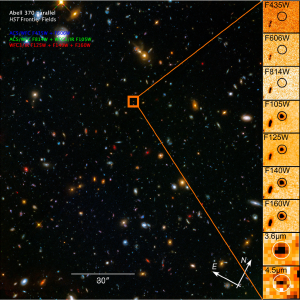Blog
A Distant Light
5 July 2020
Three hundred and seventy thousand years after the big bang, the universe became transparent and dark. The hydrogen and helium produced during the big bang had cooled to become neutral gasses, and stars and galaxies had not yet formed. The universe entered the period known as the dark ages. Then about a billion years after the big bang, universe entered a period of reionization. The neutral hydrogen was struck by intense light, causing the protons and electrons to separate or ionize.
 NASA, ESA, Z. Levay (STSci)
NASA, ESA, Z. Levay (STSci)We know that reonization was complete about a billion years after the big bang, but we haven’t been entirely sure of the cause. One idea was that very early galaxies emitted ultraviolet light, and that this light ionized the diffuse hydrogen in intergalactic space. But these galaxies would be so distant and dim that we wouldn’t be able to see them now. But a new disovery supports a different idea.1
The work was presented at the virtual annual meeting of the European Astronomical Society (EAS), and presents the discovery of a highly luminous galaxy seen from a time when the universe was only 800 million years old. The galaxy is so bright that most of the high-energy photons escape the galaxy, and can ionize the surrounding hydrogen. This discovery supports the oligarchy model of early galaxies, in which a few bright galaxies are the cause of reionization rather than lots of smaller, dimmer galaxies.
So it seems in the early universe, the future looked bright after all.
Romain Meyer, et al. “Double-Peaked Lyman-Alpha Emission at z = 6.803: A Reionisation-Era Galaxy Self-Ionising Its Local H II Bubble.” Submitted to Monthly Notices of the Royal Astronomical Society. ↩︎